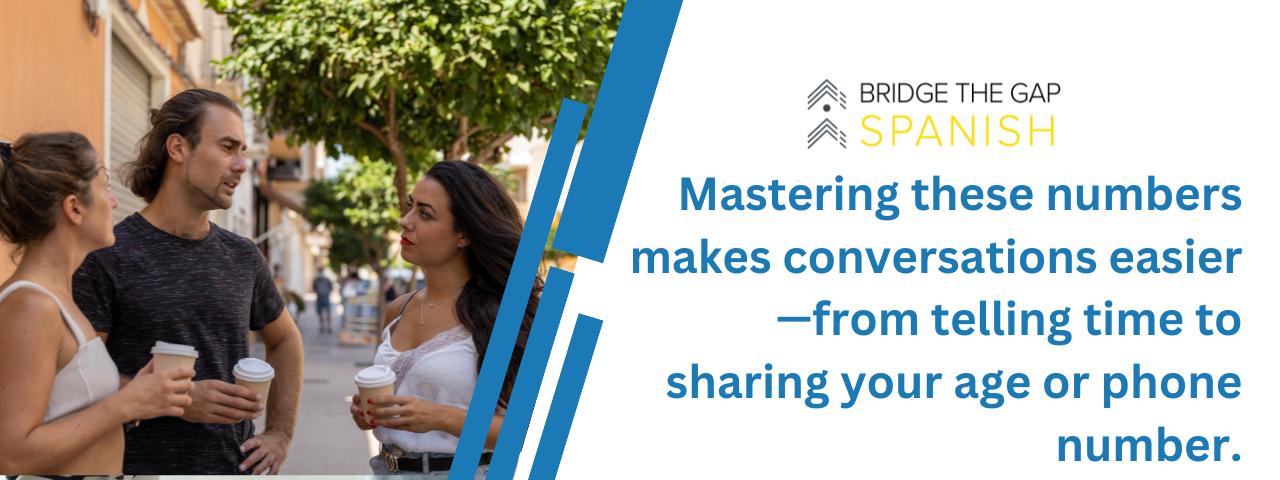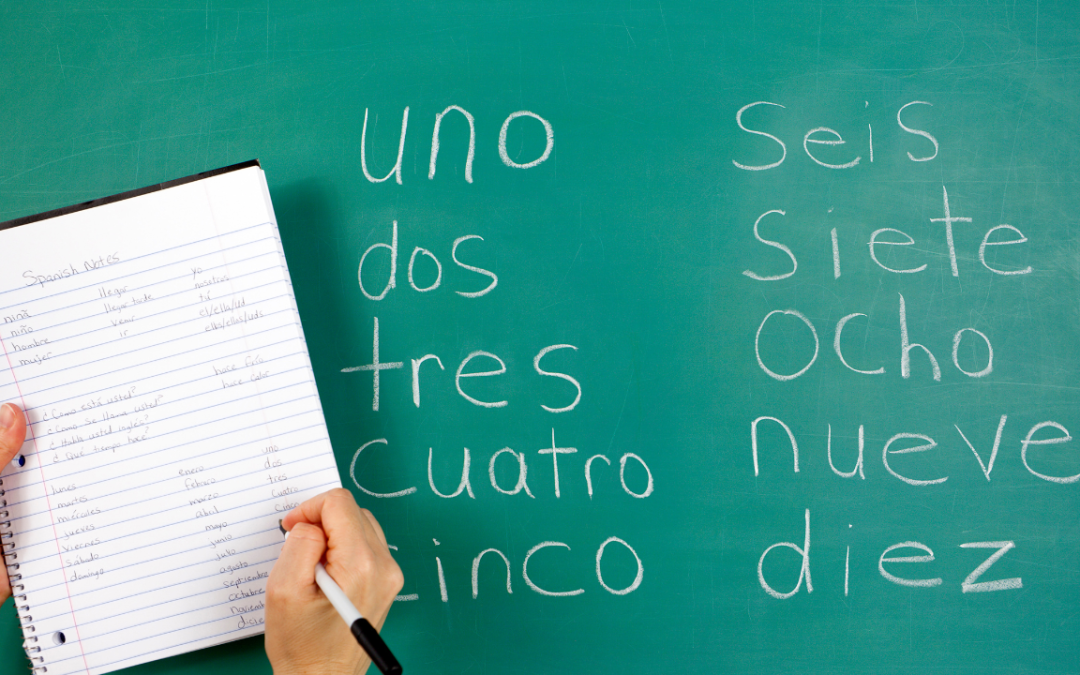Want to count to 100 in Spanish? This guide is for you. You’ll learn the numbers from 1 to 100, recognize helpful patterns, and get tips for remembering and pronouncing them. We’ll also show you how to use these numbers in real life—whether you’re telling time, talking about prices, giving your age, or writing dates. Plus, we’ve included practice tips and a free printable chart to help you study on your own.
What’s the Easiest Way to Learn Spanish Numbers?
Learning to count in Spanish doesn’t have to be overwhelming. In fact, the easiest way is to break it into bite-sized pieces and look for the patterns that make everything click.
Start by memorizing:
-
Numbers 1–19
-
The “tens” (20, 30, 40, 50, etc.)
From there, most numbers follow a super predictable formula:
[Tens word] + y + [Unit]
Like treinta y uno (31) or setenta y cinco (75)
This formula means you don’t need to memorize every single number—just recognize how the parts work together. Once you get used to the rhythm, Spanish numbers start to feel second nature. Keep practicing, and you’ll be surprised how fast it becomes automatic.
Numbers in Spanish: 1 to 10
Before we dive into the full list, let’s start with the basics. The numbers 1 through 10 are your building blocks. You’ll use them constantly—in time, prices, dates, and more. Learning them well gives you a solid foundation for everything that follows.
These are the most basic Spanish numbers and form the foundation for everything else:
-
1 – uno (OO-no)
-
2 – dos (dose)
-
3 – tres (trehs)
-
4 – cuatro (KWA-tro)
-
5 – cinco (SEEN-ko)
-
6 – seis (sace)
-
7 – siete (SYEH-teh)
-
8 – ocho (O-cho)
-
9 – nueve (NWAY-beh)
-
10 – diez (dyehs)
Numbers in Spanish: 11 to 20
These numbers don’t follow a clear pattern, so take a little extra time to learn them:
-
11 – once (OWN-seh)
-
12 – doce (DOH-seh)
-
13 – trece (TREH-seh)
-
14 – catorce (kah-TOR-seh)
-
15 – quince (KEEN-seh)
-
16 – dieciséis (dyeh-see-SAYS)
-
17 – diecisiete (dyeh-see-SYEH-teh)
-
18 – dieciocho (dyeh-see-O-cho)
-
19 – diecinueve (dyeh-see-NWAY-beh)
-
20 – veinte (BEYN-teh)
Numbers in Spanish: 21 to 29
Spanish numbers 21–29 begin with the prefix veinti- and are written as one word, rather than separate parts like the other numbers you’ll see later. This group has its own look and rhythm, so it’s a good idea to get comfortable with them early on. You’ll spot this pattern in phone numbers, prices, and street addresses—so it’s worth practicing a few times until it sticks:
-
21 – veintiuno
-
22 – veintidós
-
23 – veintitrés
-
24 – veinticuatro
-
25 – veinticinco
-
26 – veintiséis
-
27 – veintisiete
-
28 – veintiocho
-
29 – veintinueve
Numbers in Spanish: 30 to 39
Start with the base: Treinta (TREYN-tah). Numbers 31–39 are written as three words: base + y + unit.
-
30 – treinta
-
31 – treinta y uno
-
32 – treinta y dos
-
33 – treinta y tres
-
34 – treinta y cuatro
-
35 – treinta y cinco
-
36 – treinta y seis
-
37 – treinta y siete
-
38 – treinta y ocho
-
39 – treinta y nueve
Numbers in Spanish: 40 to 49
Base word: Cuarenta (kwah-REN-tah) — this is your starting point for all the numbers in the forties. Just like with the thirties, you’ll take this base and add “y” plus the next number to form the rest. Once you know the base, the rest fall into place easily.
-
40 – cuarenta
-
41 – cuarenta y uno
-
42 – cuarenta y dos
-
43 – cuarenta y tres
-
44 – cuarenta y cuatro
-
45 – cuarenta y cinco
-
46 – cuarenta y seis
-
47 – cuarenta y siete
-
48 – cuarenta y ocho
-
49 – cuarenta y nueve
Numbers in Spanish: 50 to 59
Base word: Cincuenta (seen-KWEN-tah) — this is the word for fifty. Just like with cuarenta and treinta, you’ll add “y” plus the next number to go from 51 to 59. Once you’re comfortable with this format, building any number in this range becomes automatic.
-
50 – cincuenta
-
51 – cincuenta y uno
-
52 – cincuenta y dos
-
53 – cincuenta y tres
-
54 – cincuenta y cuatro
-
55 – cincuenta y cinco
-
56 – cincuenta y seis
-
57 – cincuenta y siete
-
58 – cincuenta y ocho
-
59 – cincuenta y nueve
Numbers in Spanish: 60 to 69
Base word: Sesenta (seh-SEN-tah) — this is the word for sixty. I’m sure you’re starting to see a pattern here! Just keep doing what you’ve been doing with the other sets.
-
60 – sesenta
-
61 – sesenta y uno
-
62 – sesenta y dos
-
63 – sesenta y tres
-
64 – sesenta y cuatro
-
65 – sesenta y cinco
-
66 – sesenta y seis
-
67 – sesenta y siete
-
68 – sesenta y ocho
-
69 – sesenta y nueve
Numbers in Spanish: 70 to 79
Base word: Setenta (seh-TEN-tah) — this marks the start of the seventies. By now, you’re probably seeing how consistent the pattern is!
-
70 – setenta
-
71 – setenta y uno
-
72 – setenta y dos
-
73 – setenta y tres
-
74 – setenta y cuatro
-
75 – setenta y cinco
-
76 – setenta y seis
-
77 – setenta y siete
-
78 – setenta y ocho
-
79 – setenta y nueve
Numbers in Spanish: 80 to 89
Base word: Ochenta (oh-CHEN-tah) — the pattern continues.
-
80 – ochenta
-
81 – ochenta y uno
-
82 – ochenta y dos
-
83 – ochenta y tres
-
84 – ochenta y cuatro
-
85 – ochenta y cinco
-
86 – ochenta y seis
-
87 – ochenta y siete
-
88 – ochenta y ocho
-
89 – ochenta y nueve
Numbers in Spanish: 90 to 100
Base word: Noventa (noh-VEN-tah) — you’re almost to 100!
-
90 – noventa
-
91 – noventa y uno
-
92 – noventa y dos
-
93 – noventa y tres
-
94 – noventa y cuatro
-
95 – noventa y cinco
-
96 – noventa y seis
-
97 – noventa y siete
-
98 – noventa y ocho
-
99 – noventa y nueve
-
100 – cien (see-EN)
👉 Note: Use cien for exactly 100. But once you go past 100, the form changes to ciento. So, 101 is ciento uno, 132 is ciento treinta y dos, and so on. It’s a small shift, but an important one to keep your Spanish sounding natural. Don’t worry—we’ll go deeper into numbers beyond 100 in another post!
How to Use Spanish Numbers in Daily Life
Spanish numbers aren’t just something you memorize—they’re tools you’ll use every day. The more you apply them in practical, real-world settings, the faster they’ll become second nature.
Here are some common places you’ll see them pop up:
Telling time: “Son las tres y veinte” (It’s 3:20). You’ll need numbers to understand and express time accurately throughout the day.
Prices: “Cuesta cuarenta y cinco dólares” (It costs 45 dollars). Whether you’re at a store, market, or restaurant, knowing numbers helps you make purchases and ask about costs.
Giving your age: “Tengo treinta y dos años” (I’m 32 years old). Talking about your age—or asking someone else’s—is one of the most basic conversation starters.
Dates: “Hoy es el veinte de junio” (Today is the 20th of June). Spanish speakers say the day before the month, so recognizing numbers helps you get dates right.
The more you see and use numbers in these everyday moments, the more natural and useful they’ll feel.
Tips for Practicing Spanish Numbers
The key to remembering Spanish numbers is regular, meaningful practice. Here are some of the most effective ways to build fluency:
-
Create flashcards or a printable chart — Visual tools help you see and remember the structure. Grab your free chart here.
-
Count out loud during everyday tasks — Like brushing your teeth, walking upstairs, counting steps on your walk, or putting groceries away. Look for moments when you’re already doing something repetitive—those are perfect chances to sneak in a little Spanish.
-
Watch videos or listen to songs that include numbers — Exposure through music and speech helps you retain pronunciation and rhythm.
-
Practice with someone — Whether it’s a language partner, a friend, or one of our tutors, speaking with another person helps lock things in and builds confidence.
To Sum It All Up
Learning the first 100 Spanish numbers is a simple, confidence-boosting step early on in your language journey—they’re useful in everyday conversations and show up constantly in real-life situations. Knowing these numbers helps with everyday stuff, like checking prices, telling the time, or sharing your phone number.
Want a quick reference? Grab our free Spanish Number Chart—it lists numbers 1 to 100 with pronunciation so you can review them anytime.
Practice regularly, use real-life examples, and don’t stress about perfection. The more you speak and listen, the easier it gets. ¡Vamos!, use real-life examples, and don’t stress about perfection. The more you speak and listen, the easier it gets. ¡Vamos!
Learn with Bridge the Gap Spanish
Want to practice numbers (and so much more) with a real person? Bridge the Gap Spanish offers live 1-on-1 lessons with friendly, native Spanish speakers. Our team isn’t just fluent—they’re trained educators who know how to help you grow, step by step.
Whether you’re working on pronunciation, learning grammar, or just trying to build confidence in real conversations, we’re here to help you every step of the way. Perfect for beginners or anyone ready to build fluency and feel more comfortable using Spanish in everyday life.
Ready to take the next step? Schedule a free discovery call and let’s build your Spanish skills—together
Frequently Asked Questions
What are the numbers from 1 to 10 in Spanish?
They’re uno, dos, tres, cuatro, cinco, seis, siete, ocho, nueve, and diez. These are your foundation, and once you’ve got them down, the rest builds on top. Simple and super useful.
How do I pronounce Spanish numbers correctly?
It depends a little on where you’re learning. In Spain, the letter “Z” and the soft “C” (before E or I, like in cinco) sound like “TH” (as in thin), while in Latin America, they’re pronounced like “S.” But when “C” comes before A, O, or U, it makes a K sound—like in cuatro or cuarenta.
What are some common mistakes when learning Spanish numbers?
Some learners get tripped up with pronunciation or mixing up the order of words—especially when using “y” between numbers. Also, don’t assume numbers always sound the way they’re spelled. Practice out loud to get the hang of it.
How do I count beyond 100 in Spanish?
You just add to “ciento.” For example, 101 is ciento uno and 135 is ciento treinta y cinco. After you’ve learned the first 100, the rest becomes a mix-and-match game. We’ll break that down in another post!
What are some practical uses of Spanish numbers?
They come up all the time! Whether you’re telling time, ordering food, booking travel, or just chatting about your age, numbers are essential for real-life Spanish conversations. The more you use them, the more natural they become.


